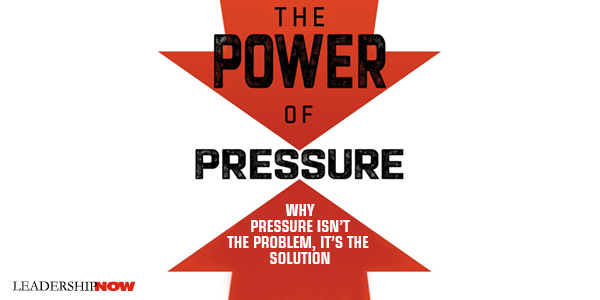 |
 |
09.06.21

The Power of Pressure
SCOTTISH philosopher Thomas Carlyle is said to have written, “No pressure, no diamonds.” And it’s true. We need to rethink how we think of pressure and how we manage it. In The Power of Pressure, Dane Jensen says, “Pressure isn’t just a nasty by-product of life, it’s an essential input into high performance. A life well-lived requires pressure.” If we can link pressure to growth, we have a great foundation to work from. So, while most of us try to eliminate or avoid pressure, maybe we need to see it as an ally. Jensen provides the understanding to do just that. He says, “pressure has patterns, and those patterns repeat.” What creates pressure is the need to do something, and that distinguishes it from other states like stress, fear, or grief. Unfortunately, just when we feel the need to do something, “our body’s default response to pressure robs us of the very abilities that can most help us manage our response to pressure.” That’s the paradox of pressure. We can become so narrowly focused under pressure that our ability to process information shrinks, and our ability to absorb helpful information diminishes. Over the long haul, if we stay in this high-pressure state, this narrow focus can become our brain’s default. So, we need a strategy. Two Kinds of Pressure Broadly speaking, there are peak pressure moments — “short, violent bursts of extreme importance and uncertainty” — and there is pressure over the long haul — “periods of grinding volume mixed with importance and uncertainty along the way.” To manage them well, we need to respond differently to each. Peak pressure moments are those that have a beginning and an end and “with a clear range of outcomes” like a race, a test, or a speech. When the moment is over, so is the pressure. “In peak pressure moments, the goal is simple: perform.” It is about “performing to the peak of your abilities instead of shrinking from the moment.” Long haul pressure is different. It can be pressure leading to a peak pressure moment, or, more often, it can simply exist. “This type of long haul can come on gradually, as additional sources of pressure are slowly layered on, one by one, until you realize you are no longer sleeping well at night or are feeling emotionally overwhelmed, unable to focus.” Jensen has identified three factors common to all pressure that exist in some combination: high importance, high uncertainty, and high volume. Together they form the Pressure Equation: PRESSURE = IMPORTANCE x UNCERTAINTY x VOLUME Importance has to do with the importance of the outcome. If you see the outcome of a situation as important, it will create some kind of pressure. But combined with uncertainty, it becomes intense pressure. Volume is what makes pressure relentless — the volume of importance. And we can all relate (well, most of us) to this from an example in the book: No team of people, no matter how capable or well-meaning, can truly attend to 189 things — which means that inevitably some of these important, uncertain items will migrate to the periphery, creating pressure each time you think of them and feel the sting of guilt over there neglect. With this in mind, we need to become what Jensen calls Pressure Ambidextrous. That is to say, learning to be “better at both performing in peak pressure moments and approaching the long haul with a sense of challenge, commitment, and motivation.” This is where his Power of Pressure Model is helpful.
Jensen takes six chapters to explain the strategy for each type of pressure and how we can best use it to our advantage. Each chapter has fresh, well-thought-out perspectives, behaviors, and insightful questions to guide us through the model. He gives this overview of each strategy as it relates to the two pressure types: Long Haul Importance: Connect with why it matters. Over the long haul, navigating importance is about creating a clear line of sight from the day-to-day grind to what matters most to you. It’s about keeping importance front and center in the midst of all the ups and downs that accompany any busy life. When our daily decisions become disconnected from what matters to us for too long, it is hard to sustain a sense of commitment to the journey. Jensen says that much of this boils down to attention control. “The ultimate solution to the pressure equation is being able to consciously and deliberately direct the spotlight of our attention to focus on the thoughts, beliefs, and habits that support us rather than undermine us.” The Power of Pressure is an outstanding book, and you can find whitepapers to support these ideas on his website. 
Posted by Michael McKinney at 03:20 PM
|
BUILD YOUR KNOWLEDGE
 

How to Do Your Start-Up Right STRAIGHT TALK FOR START-UPS 
Grow Your Leadership Skills NEW AND UPCOMING LEADERSHIP BOOKS 
Leadership Minute BITE-SIZE CONCEPTS YOU CAN CHEW ON 
Classic Leadership Books BOOKS TO READ BEFORE YOU LEAD |